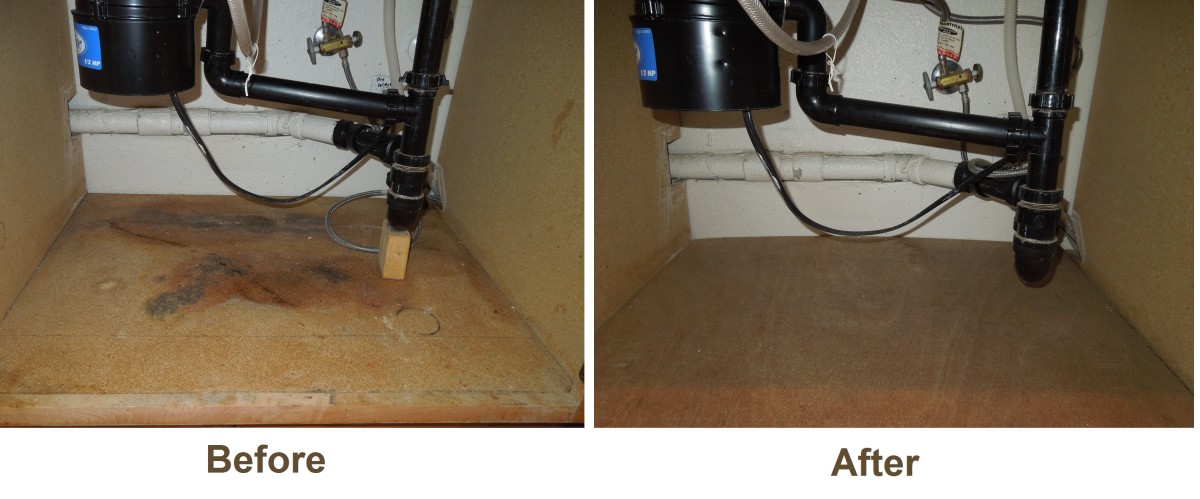Discovering mold under the kitchen sink cabinet can be a concerning issue for homeowners. Mold thrives in damp and dark environments, making the space under the sink an ideal breeding ground if there’s a persistent moisture problem. The first step in addressing mold under the kitchen sink cabinet is identifying the source of moisture. Common culprits include leaking pipes, faucet connections, or a faulty garbage disposal. It’s essential to fix these issues promptly to prevent further mold growth.
Cleaning the mold is the next crucial step. Use a mixture of water and mild detergent to scrub the affected areas thoroughly. For stubborn mold, a solution of vinegar and baking soda can be effective. Ensure that the area is completely dry after cleaning, as mold thrives in moisture. Consider using a fan or dehumidifier to expedite the drying process and prevent future mold development.
Inspect the cabinet for any structural damage caused by the mold. Mold can compromise the integrity of wood and other materials, leading to decay and potential safety hazards. Replace any damaged components and consider using mold-resistant materials for future cabinet renovations to minimize the risk of mold recurrence.

To prevent mold from returning, address the root cause of the moisture issue. Regularly check for leaks and fix them promptly. Consider installing a drip tray or waterproof liner in the cabinet under the sink to catch any potential water leaks and make cleaning easier. Proper ventilation in the kitchen is also crucial in preventing mold growth, so ensure that the area is well-ventilated.
Using mold-resistant paint on the cabinet surfaces can be a proactive measure to discourage mold growth. Mold-resistant paints contain antimicrobial agents that inhibit the growth of mold and mildew. Applying a coat of such paint, especially in areas prone to moisture, adds an extra layer of protection against future mold issues.
Inspect the items stored under the kitchen sink regularly. Items like cleaning supplies or dish soap can sometimes leak, contributing to moisture buildup. Keep the area organized and ensure that all containers are tightly sealed to minimize the risk of spills. Consider using plastic bins or trays to contain any potential leaks and make cleaning more manageable.

For severe mold infestations, it might be necessary to consult with professionals. Mold remediation specialists can assess the extent of the problem, identify hidden mold, and implement effective strategies for removal. Professional assistance is particularly crucial if the mold has spread to other areas of the home or if there are concerns about the type of mold present.
Investigate if there are any issues with the plumbing system that may contribute to mold growth. Leaky pipes or a malfunctioning garbage disposal can introduce moisture into the cabinet, creating an environment conducive to mold. Addressing these plumbing issues promptly is essential in preventing recurring mold problems.
Consider using moisture-absorbing products, such as silica gel packets or desiccants, under the kitchen sink. These products help control humidity levels, reducing the likelihood of mold growth. Replace or recharge these products regularly to ensure their continued effectiveness in maintaining a dry environment.

Educate yourself about the different types of mold and their potential health implications. While not all molds are harmful, some can produce mycotoxins that pose health risks, especially for individuals with respiratory conditions or allergies. If you suspect the presence of toxic mold, it’s advisable to consult with a healthcare professional and consider more thorough testing and remediation.
Regularly inspect the caulking and seals around the sink and countertop. Worn or damaged seals can allow water to seep into the cabinet, creating conditions for mold growth. Reapply caulk as needed to maintain a watertight seal and prevent moisture infiltration.
Consider investing in a waterproof cabinet mat or liner. These mats are designed to trap and contain any liquids that may spill or leak, preventing them from reaching the cabinet surface. Easy to clean and replace, waterproof mats provide an added layer of protection against moisture-related issues, including mold.

Incorporate good ventilation practices in the kitchen. Proper ventilation helps reduce humidity levels and promotes air circulation, creating an environment less conducive to mold growth. Use exhaust fans, open windows when possible, and ensure that vents are unobstructed to facilitate the flow of fresh air.
Regularly inspect and maintain the sink’s plumbing components. Check for signs of wear, corrosion, or leaks and address any issues promptly. Implementing a routine maintenance schedule for plumbing can help catch potential problems before they escalate, reducing the risk of mold under the kitchen sink.
Ensure that the cabinet under the sink is well-insulated. Proper insulation helps prevent condensation, reducing the chances of moisture buildup. Insulating the cabinet can be especially beneficial in climates where temperature variations can contribute to humidity and dampness.
Addressing mold under the kitchen sink cabinet requires a systematic approach that includes identifying and fixing the source of moisture, thorough cleaning, and preventive measures. Regular inspections, good ventilation, and proactive maintenance are key components of a strategy to prevent mold growth and ensure a healthy kitchen environment. Taking these steps not only protects the structural integrity of the cabinet but also contributes to the overall well-being of the home and its occupants.

Kitchen Sink Mold?

Fisherman’s Wife Furniture: Waterproofing Under the Sink

Mould under the kitchen sink.

Xtreme Mats Beige Bathroom Vanity Depth Under Sink Cabinet Mat Drip Tray Shelf Liner (21-5/8 in

How to Replace Rotted Wood Under a Kitchen Sink Dengarden

angled plugmold to hide kitchen outlets. Plugmolds hide under the upper kitchen cabinets. Is

Related Posts: